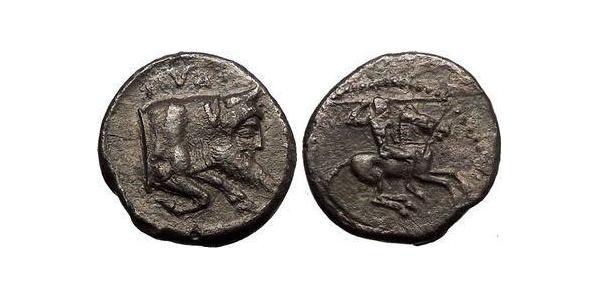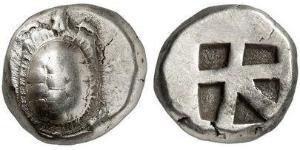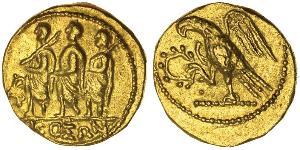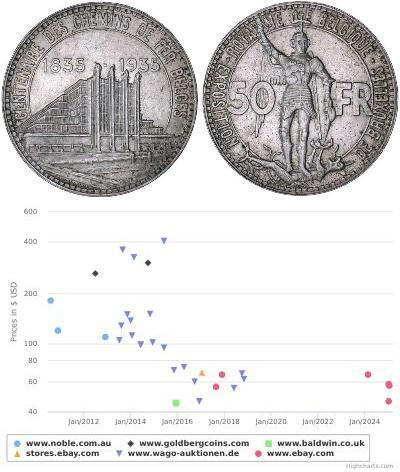[ 5191] SICILY: GELA - Silver Didrachm (21mm,8.25 gm.) Struck 490-475 B.C. Reference: Jenkins, Gela, 67; SNG Copenhagen 255;SNG ANS 12. Horseman galloping right, wearing headdress and holding apear, dotted border. Forepart of man-headed bull right; CEΛAΣ above. Provided with certificate of authenticity. CERTIFIED AUTHENTIC by Sergey Nechayev, PhD - Numismatic Expert The third city of ancient Sicily, after Syracuse and Akragas, Gela was founded circa 688 B.C. by colonists from Crete and Rhodes. The place was named from the river Gelas which flowed to the east of the settlement. Throughout most of the latter part of the 5th Century Gela enjoyed great prosperity; but in 405 B.C. the city was destroyed by the Carthaginians, a disaster from which it never fully recovered. Then the city was destroyed by the Mamertini in circa 282 B.C., the survivors moving to the newly-founded Phintias. The city was founded around 688 BC by colonists from Rhodos (Rhodes) and Crete, 45 years after the founding of Syracuse. The city was named after the river Gela. The Greeks had many colonies in the south of what is now Italy, and for many centuries the Greeks had a major influence on the area. Gela flourished and, after only a century, a group of Geloi founded the colony of Agrigento. The expansion, however, led to economic and social strains, which led the plebs to leave the city and settle in nearby Maktorion. However, the revolt was opposed by the great priest of Diana and the exiled plebs returned to Gela. For over a century no further mention is made about the internal politics of the city, until the ancient historians note that a tyrant, Cleander, ruled Gela between 505 BC and 498 BC. After his death, power transferred to his brother Hippocrates, who conquered Callipoli, Leontini, Naxos, Hergetios and Zancles, the current Messina. Only Syracuse, with the help of her former colonizing city, Corinth and Corcyra, managed to escape the Gelese expansion. When Camarina, a Syracusan colony, rebelled in 492 BC, Hippocrates intervened to wage war against Syracuse. After having defeated the Syracusan army at the Heloros river, he besieged the city. However, in the end he was convinced to retreat in exchange for the possession of Camarina. The tyrant lost his life in 491 in a battle against the Siculi, the native Sicilian people. Hippocrates was succeeded by Gelo, who, in 484, conquered Syracuse and moved his seat of government there. His brother Hiero was given control over Gela. When Theron of Agrigento conquered Himera and a Carthaginian army disembarked in Sicily to counter him, he asked for help from Gela and Syracuse. Gelo and Hiero were victorious in the subsequent battle of Himera, in which the Carthaginian leader Hamilcar lost his life. After the death of Gelo (478 BC), Hiero moved to Syracuse, leaving Gela to Polyzelos. Thenceforth the history of the city becomes uncertain: it has been suggested that the citizens freed themselves from the rule of tyrants and established a democratic government. Many of the Geloi returned from Syracuse in this period, and the city regained part of its power: Aischylos died in this city in 456 BC. Gela was at the head of the Sicilian league that pushed back the Athenian attempt to conquer the island in 424 (see Sicilian Expedition). In 406 the Carthaginians conquered Agrigento and destroyed it. Gela asked for the help of Dionysius I of Syracuse. However, for unknown reasons, the latter did not arrive in time and, after heroic deeds, Gela was turned into ruins and its treasures sacked (405). The survivors took refuge in Syracuse. In 397 they returned home and joined Dionysius II in his struggle for the freedom from the invaders, and in 383 BC they saw their independence acknowledged. Under Agathocles (317-289 BC) the city suffered again for internal strife between the general population and the aristocrats. When the Carthaginians arrived in 311 BC, they met little resistance and captured the ci ...
type to read more

|
Posted by:
anonymous 2015-08-18 |
Similar Coin Groups
2025-05-24
- Historical Coin Prices
2025-05-25
- New coin is added to 2 Liard Austrian Netherlands (1713-1795) Copper
2 Liard Austrian Netherlands (1713-1795) Copper
group has 3 coins / 3 prices
⇑
1777, Austrian Netherlands, Maria Theresa. Copper 2 Liards (2 Oorden) Coin. VF- Mint Year: 1777 Reference: KM-29. Denomination: 2 Liards (2 Oorden) Mint Place: Brussels (cupid´s head) ...
You may be interested in ...















-300-150-zTgKbzbixN4AAAFSpQBzJO3T.jpg)






